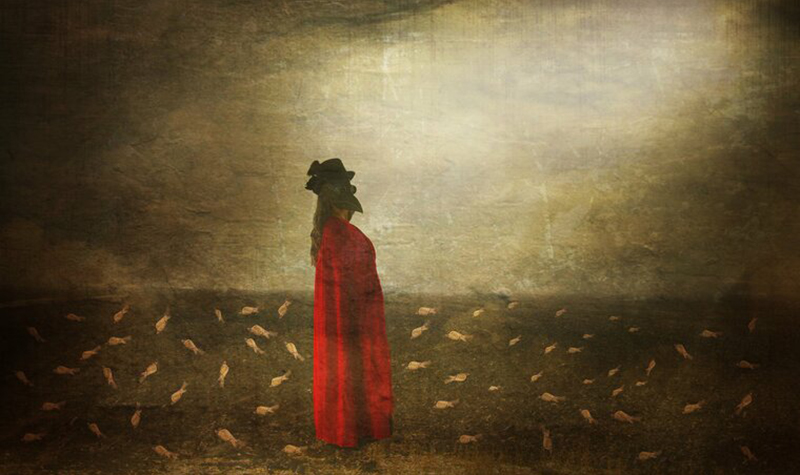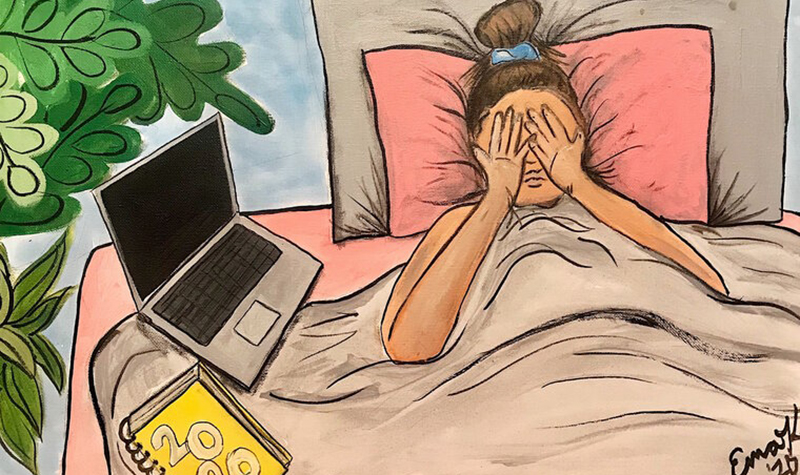UND Art Collections presents first virtual exhibit of student artworks
The latest exhibit showcases students’ interpretations of the coronavirus

If the coronavirus pandemic came with its own zeitgeist, it could be aptly summarized as: “To many of us, it seems like we’ve gained all the time in the world while losing the freedoms that we once had, creating a weird dissonance within our days.”
This is what Tyler Pierson, who serves as the graduate research assistant at the University of North Dakota’s Art Collections while obtaining his master’s degree in fine arts, penned atop the curatorial statement of the latest UND exhibit of student pieces that interpret this unprecedented time of COVID-19.
“Free Time: It’s Not What We Thought It Would Be” is Art Collections’ first ever virtual art exhibit that comes in a rather propitious time for online engagement. In the couple of months since the coronavirus began coursing through the country, a series of art galleries and museums have taken to the internet to display their treasures.
“We wanted to put together a virtual exhibition so that we could still showcase students’ work and provide an opportunity for them to still showcase their artworks in a time period in which we can’t put on shows, say in the Empire Arts Center in downtown Grand Forks,” said Pierson. “We also wanted to continue to provide meaningful works for the community that we wouldn’t otherwise be able to while everyone is on lockdown.”
Opening May 1, “Free Time” has been made possible through the financial support of the Myers Foundation, which is also providing funding for the purchase of several student artworks.
The exhibit holds on its virtual white walls, built on the German Kunstmatrix online platform, 23 artworks created by 13 student artists. Some of the pieces were natively digital, others had to be photographed and uploaded. There is also one sculpture captured in an image that flattens it for 2D viewing experience.
“Virtually, viewers can click on the artworks and then the information about the artwork and the artist comes up on the screen for them to read or they can also listen to an audio file,” said Sarah Heitkamp, manager and curator of the Art Collections. “That’s really where the interactive part comes in. The viewer can look at the gallery however they decide to look at it.”
Putting together the show took about a month in which Pierson and Heitkamp set up the digital infrastructure, while a call for artworks prompted UND students to capture their experiences during the coronavirus pandemic.
“Putting together a virtual exhibition has been a very unique, equally challenging and equally rewarding experience,” said Pierson.
He is also participating in the exhibit with two pieces, titled “Liberties imposed isolation” and “The weight of a human life.” His works have no backgrounds; just figures – the central spot belongs to Lady Liberty in one and Lady Justice in the other – whose complex interactions pack meaning, allegories and symbolism.
The pieces cue to fragility and vulnerability, “which are certainly something that a lot of people seem to be experiencing within this isolation period,” Pierson said.
Kristen Peterson, a part-time student pursuing her bachelor’s degree in fine art while working as a secretary at the School of Medicine and Health Sciences, also depicts the fright brought on by the virus in her piece named “Isolation.”
“It is a reflection of what I am feeling at the time because there’s so much fear and death right now and it’s a really dark time,” Peterson said.
There are also so many masks, which prompted Peterson to, in a way, explore the extreme – with a plague doctor mask. The latter rests on the face of a woman, cloaked in a red cape, who stands upright amid a dark flat landscape covered in leaves. If one looks closer, though, the leaves are actually one and the same and are not leaves at all but the tiny little body of a dead robin.
Peterson, who is a fine photography artist, found the lifeless bird in her yard and snapped an image of it. She also took a photo of a field and of herself, wearing the mask, the cape and a wig. Then, she spliced all the elements together digitally. But it is not all doom.
“It’s really dark in the piece but in the middle, there’s this bright light, which I thought symbolizes hope,” Peterson said. “There’s always going to be hope, even in the darkest of time.”

Emma Klindworth, and art education senior, took a different approach to expressing her feelings. Working with acrylics in her parent’s formal dining room, which she had turned into her art studio during the pandemic, she created “Isolated Classroom.” The piece captures her frustration – in vivid colors.
“A lot of my artwork focuses on florals, and more nature inspired works,” Klindworth said.
There are a couple of bright green plants peeking from the side as a laptop and a notebook lie on a bed where a student sticks her arms from under the sheets to cover her face.
If I am doing classwork I’m usually laying in my bed,” Klindworth said. “Just because I’m not in my apartment and I don’t have my space to do my work. I want people to be able to relate to that a little bit. I feel like a lot of people are in that same boat. All of my routines have been kind of thrown out the window.”
Yet, art, in its many iterations, has a space – and a purpose – in this new normal. It not only helps fill the void the pandemic has carved. It also helps make sense of it.
“We’re all at home,” Peterson said. “Everyone is watching movies or television shows. They’re reading books or listening to music. That’s all made by artists. That’s why art is so important. What’s keeping us going right now is art.”
“Free Time: It’s Not What We Thought It Would Be” opens on May 1 at 10 am and can be viewed virtually.


